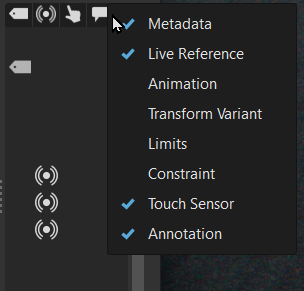How Live References Work In VRED
The Alias user determines when Alias data is shared with VRED in a Live Reference. When the Alias user selects Enable Live, a Live Reference of the Alias data is created, which can then be shared with VRED. When the Alias user selects Enable on Save, the Live Reference data is created or updated after the .wire file is saved in Alias. An Alias user can also select Sync to update an existing Live Reference without needing to save the .wire file.
In VRED, you create a connection to Live Reference data. The data appears the same in both applications without additional modifications; therefore, as Alias modelers work on their content, their changes are seen by VRED visualization experts.
The VRED user can choose when to consume Alias scene changes. They can select Update from Alias to periodically load Alias changes as they like or Automatic Update to automatically load changes to the Alias Live Reference data into VRED.
These update options enable two workflows:
Use Auto Update when using Alias and VRED together to see Alias changes live in VRED. This could be for using raytracing for advanced visualization and surface diagnosis, or when making model changes to a scene being presented in VRED during a review.
Use Update from Alias when updating the Live Reference at a time that is convenient for you, without being interrupted by live changes in Alias.
How Alias Content is Handled
Let's look at what comes through from Alias in a Live Reference to better set your expectations. This section provides information on what does and does not come through, as well as what is created, if things aren't brought over as expected. Release versions may appear next in entries to indicate when updates, improvements, or changes occurred.
For more information on what is included in a live reference on the Alias side, as well as exclused, see How Live References Work in Alias.
Animation and Annotations from Alias
Find support for the following when using Live Reference:
As of version 2026.1, to help visually identify Live Reference nodes, we added a Live Reference column to the Expansion Column of Annotations. Double-clicking the icon opens the Live Reference module with the node selected. Click
 to access a menu for displaying or hiding this.
to access a menu for displaying or hiding this.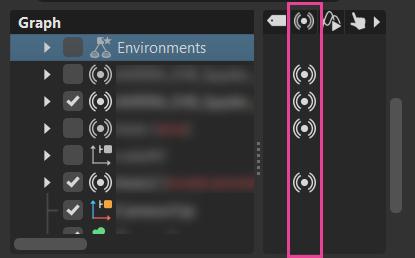
When an Alias user makes changes to transform or geometry animations, VRED shows these changes, as long as Automatic Update is enabled.
When an Alias user makes changes to an annotation, VRED displays these changes, as long as Automatic Update is enabled.
Limitation: At present, annotations created in VRED are not exportable to Alias.
Cameras from Alias
At present, when VRED pulls cameras from a Live Reference, camera position in x/y/z space and its current orientation angle are synchronized with Alias, and only basic settings, such as focus distance, clipping range, and field of view, are available. As of 2026.1, Alias depth of field changes are reflected in VRED. Camera matching from Alias is also supported in the VRED Live Reference file.
Limitation: Camera settings such as F-Stop, Autofocus, and camera scaling are not synced between Alias and VRED and orthographic cameras from Alias are currently ignored.
Environments from Alias
Limitation: VRED currently does not create or update environments through a Live Reference.
Lights from Alias
When VRED pulls lights from a Live Reference, the following light types are synchronized between Alias and VRED:
- Area Light
- Directional Light
- Spot Light
- Point Light
Limitation: Linear and Ambient Lights from Alias are not supported in VRED.
The following properties are synchronized and there is a slight change to Cast Shadows (Alias), which is mapped to Cast Shadows on Shadow Material (VRED):
- Position
- Direction
- Color
- Intensity
- On/Off state of Alias lights (as of 2026.1)
Some additional parameters are synchronized for specific light types and the values are adjusted to match the VRED light.
For Area Light, Area Size is synced.
For Spot Light, Spread (Alias) is mapped to Cone Angle (VRED) and Penumbra (Alias) is mapped to Penumbra Angle (VRED)
World Space Texture Projections from Alias
Freeze the World Space Texture Transform at the object level, if satisfied with the texture scaling, yet you might want to move or animate the model in space. Find the following options in the Scenegraph Edit and context menus.
Since this introduces an additional level of complexity and can result in different behaviors for objects that share the same material, try using the Scenegraph Selection Filter Menu ![]() > Frozen Texture Transform option. This selects all nodes in the tree and viewport with frozen texture transformations, making it easy to identify them.
> Frozen Texture Transform option. This selects all nodes in the tree and viewport with frozen texture transformations, making it easy to identify them.
Freeze World Space Texture Transform - Freezes the current world space transform of the geometry for calculating triplanar, planar, or procedural texture projections. Freezing the world space texture transform stores the current world space transform with the geometry and uses it for texture projection calculations. When the transform is frozen, any transformations on the geometry no longer affect the texture projections, keeping the resulting texture sticking to the geometry.
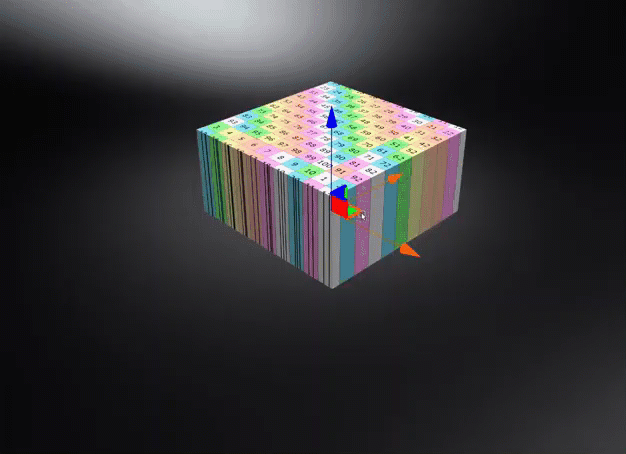
An object with a frozen world space texture projection Clear World Space Texture Transform - Removes a previously frozen world space texture transform from the geometry.
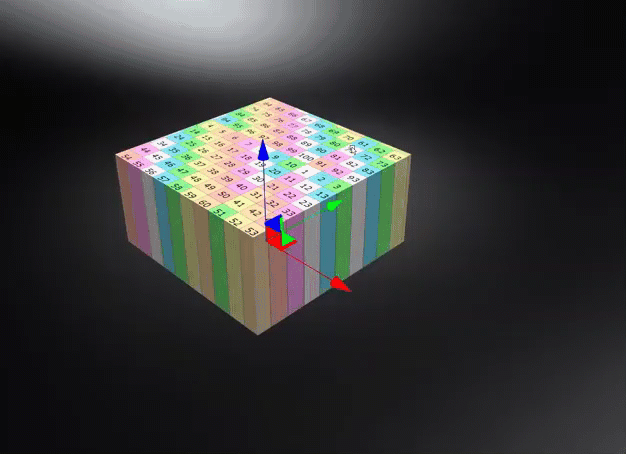
An object with an unfrozen world space texture projection
Filtering for Frozen Texture Transforms
When working in the Scenegraph, to quickly identify any frozen texture transforms, use the Frozen Texture Transform option in the Selection Filter Menu.
| Scenegraph Before | Scenegraph Filtered |
|---|---|
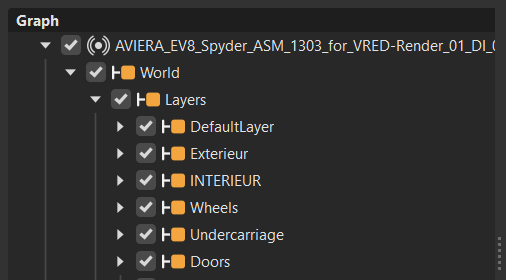 |
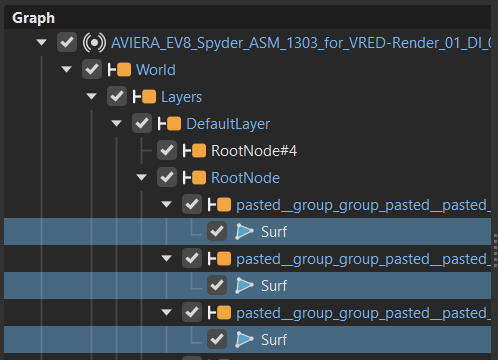 |
Setting the Projection Space
Use the Projection Space option to set the texture coordinate system used for texture projections. Find it in the Realistic tab > Common section of the Material Editor.
VRED takes into account a model's scaling and translation during texture projection, as well as when determining the size of flakes in the Carpaint material. This consideration can be beneficial, as it prevents textures with Triplanar Mapping from remaining static in space. However, it can also be problematic. For instance, if models are created in different units and have scaling applied to the root node after import, the flakes in the Carpaint material will be the wrong size. Previously, the only solutions were to flush all scalings in the Scenegraph or adjusting the Flake Size in the material, making it difficult to reuse it across multiple objects with different scalings.
Choose from:
Object Space - Calculates triplanar, planar, or procedural texture projections in object space, ensuring textures transform with the object and maintain their relative placement regardless of the object's position in the scene. Use this to rotate an object and have the texture rotate with it.
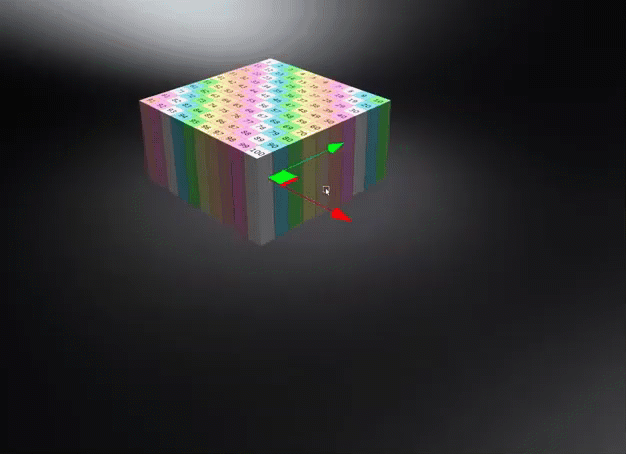
World Space - Uses the world space for calculating triplanar, planar, or procedural texture projections, where the projected textures or structures remain independent of object transformations unless the world space texture transform is frozen. Use this for a ground texture where the texture needs to be aligned to the world space. Be aware, this could cause a distortion on the surface, depending on its rotation.

Creating a Live Reference Connection
- Open the Live Reference module by selecting Select Scene > Live Reference.
- In the Live Reference module, click
 .
. - Browse to the location of the Alias .wire file used to create the Live Reference data and select it. The Create Live Reference dialog appears.
- Choose whether to apply materials from the Asset Manager before the Live Reference is created. This can save you time.
- Click OK. If no issues arise, a live connection is established between Alias and VRED, and the file is added to the Live References list.
Create Live Reference Dialog
These are the options found in the Create Live Reference dialog.

![]() Files - Lists the files that will become Live References and their locations.
Files - Lists the files that will become Live References and their locations.
![]() State - Displays the state of the Live Reference file. Before the Load button is clicked, the status is Pending and displays a loading indicator and status information. Once Load is clicked, if there are no issues, the dialog closes and the Live Reference module appears. However, if there is an issue with establishing the connection, the status reads, Failed to load Live Data and status information appears in the status bar. If you mouse over the error, a tooltip appears with additional information as to what action to take, along with the paths VRED has searched and the preferences setting.
State - Displays the state of the Live Reference file. Before the Load button is clicked, the status is Pending and displays a loading indicator and status information. Once Load is clicked, if there are no issues, the dialog closes and the Live Reference module appears. However, if there is an issue with establishing the connection, the status reads, Failed to load Live Data and status information appears in the status bar. If you mouse over the error, a tooltip appears with additional information as to what action to take, along with the paths VRED has searched and the preferences setting.
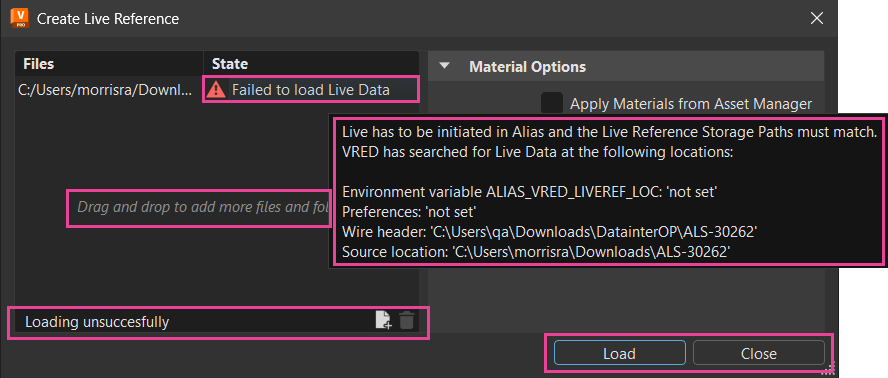
Failed loading can occur because either the paths are incorrect or the file has not been enabled live in Alias. To fix this, ensure the paths are correct. If so, ask the Alias user to either select Enable Live, Enable Live on Save, or Sync. Once this is done, in the Create Live Reference dialog, the VRED user clicks Load. Now that a connection has been established, the issue is resolved. The dialog closes and the file appears in the Live References list.

 - Adds import files to the list. Click
- Adds import files to the list. Click  . Navigate to the file or files, select them, then click Open to load them into the Files list. To the left of this option, find a loading indication and status information message.
. Navigate to the file or files, select them, then click Open to load them into the Files list. To the left of this option, find a loading indication and status information message. - Removes the selected loaded files from the list. In the Files list, select one or more files, then click
- Removes the selected loaded files from the list. In the Files list, select one or more files, then click  .
.
![]() Material Options - Provides options for applying materials from the Asset Manager to the Live Reference scene as the connection is made and the file is loaded. Click Load once finished.
Material Options - Provides options for applying materials from the Asset Manager to the Live Reference scene as the connection is made and the file is loaded. Click Load once finished.
Apply Materials from Asset Manager - Replaces shaders with the same name as Asset Manager materials and applies these to the Live Reference scene with the use of Select Folder.
- When enabled, if an Alias shader has the same name as a VRED material in the Asset Manager, VRED will overwrite the Alias shader with the Asset Manager material. Therefore, a red Alias shader with the same name as a green VRED material in the Asset Manager would be green in the Live Reference scene.
- When disabled, an Alias shader with the same name as a VRED material in the Asset Manager will not be overwritten. Therefore, a red Alias shader with the same name as a green VRED material in the Asset Manager would remain red in the Live Reference scene.
Select Folder - This option is active once Apply Materials from Asset Manager is enabled. Opens the Asset Manager for selecting and applying materials by name from the Asset Manager to the Live Reference scene.
Identifying a Live Reference
To help visually identify Live Reference nodes, use the Expansion Live Reference column found in most modules and editors.
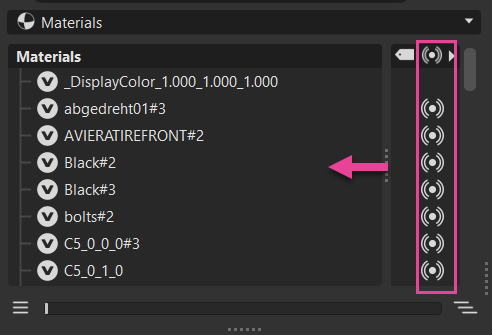
Double-clicking ![]() opens the Live Reference module with the node selected. If the Live Reference column is not displayed, use
opens the Live Reference module with the node selected. If the Live Reference column is not displayed, use ![]() to access a menu of all available columns. Placing a check next to Live Reference will add it to the columns displayed.
to access a menu of all available columns. Placing a check next to Live Reference will add it to the columns displayed.
